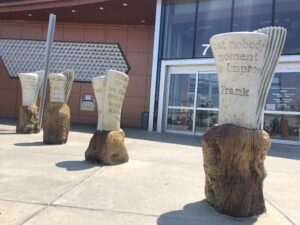NORTH NEWTON—Sculptor Conrad Snider doesn’t mean to sound rude, but if people want to hire him to make pieces to their exact specifications, he has a customary response.
“I usually tell them they need to take a ceramics class and make it for themselves,” he said. “I don’t have enough time left in my life to make things that I don’t have a personal connection to.”
Part of the North Newton resident’s interest in sculpting is the ideas behind his work and where they come from. It’s not following someone else’s plan.
However, he’s done a lot of public art projects, such as a recent installation for a sculpture tour in Salina, and he’ll work with communities to determine what’s unique about them or a particular building and have a back-and-forth exchange of ideas. Other public pieces by Snider include “Concentricity” (2018) outside the Wichita Advance Learning Library, “Opening Move” (2016) at the University of Kansas’ School of Business and Capital Federal Hall and three works for Dyck Arboretum in Salina.
Snider grew up painting and drawing in Newton. In college, when he thought he wanted to be an architect, he discovered his passion for sculpting — even though it’s “a lot of hot, heavy, dirty, hard work.”
Pace and patience
In addition to getting a ceramics and bachelor of fine arts degree from the Kansas City Art Institute, Snider did a five-year apprenticeship with large-scale Japanese ceramics sculptor Jun Kaneko, spending time in his Omaha studio and traveling the world with him.
Snider said he learned patience and pace, in part from the sculptor and in part from the clay.
“It kind of has its pace, and you have to follow its pace. You have to develop some patience to work with it.”
If you fire a piece too fast, the water in it turns to steam, and Snider said, “It will make the piece blow up.”
Snider often starts with sketches before working with clay, and then the clay almost guides him.
“Many times, the final piece doesn’t look like the sketch, but it’s a part of the process,” he said. “You’ve kind of always got ideas that are changing and then coming together. It happens a little bit more in a fluid way.”
In some ways, the medium is simple, Snider said.
“If you’ve ever dug a hole in your backyard, you’ve worked with clay. That is the beauty of it.”
At the same time, he said it’s incredibly technical, especially for larger pieces, which are his primary focus.
Unlike a small ceramic piece that someone can hold in his hands and turn to examine, a larger piece forces its viewer to walk around it to see it in its entirety, which Snider said changes the relationship.
“We’re no longer dominant in the relationship with that object.”
He said he wants his pieces to be available on different levels, and he wants people to interact with them.
“I always encourage people to . . touch things,” Snider said. “That’s one of the things that I like about public art.”
It’s also something he said he has to think about that while sculpting.
“Clay is something that should be outside,” he said. “Out where people can be around it and live with it.”
‘Always the risk’
At 61, Snider may be approaching retirement age, but as an independent artist, he said, “I won’t ever be able to afford to retire . . . and I don’t know what I’d retire to.”
His career happens to be his hobby.
Clay’s longevity appeals to Snider, who said Romans installed in-ground clay pipes 2,000 years ago that are still working.
“Having that go on beyond me and be a part of the world is something that draws me to it,” he said. “These things will be around as a record of our society.”
Snider owned a company that designed and manufactured clay-making machines before selling it a couple years ago. He has a studio in a former feed mill in downtown Newton.
Snider and his wife, Wichita attorney Diane Sorensen, live in North Newton on four acres with their cats and chickens.
Though he wouldn’t necessarily recommend the sculpting career path for others, Snider said he wouldn’t trade it for himself.
He likes “the independence of it and the freedom of it.”
Snider said the definition of success is different for different artists.
“You have to define success for yourself,” he said. “When I take my last breath, I want to have lived an interesting life.”









